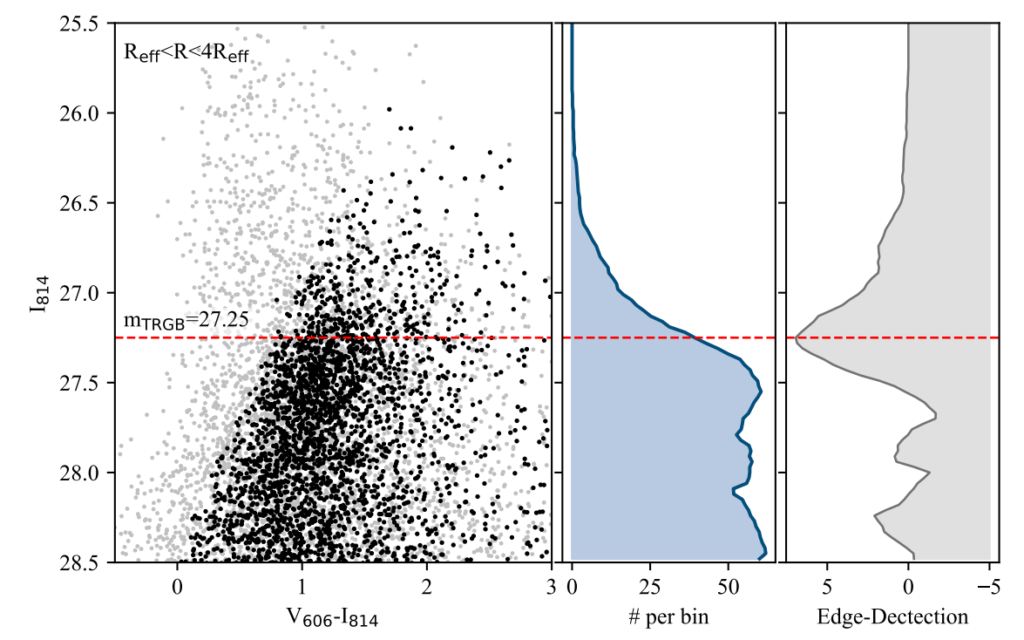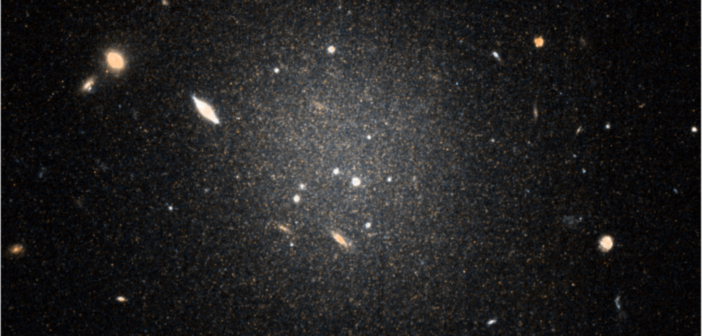Editor’s note: Astrobites is a graduate-student-run organization that digests astrophysical literature for undergraduate students. As part of the partnership between the AAS and astrobites, we occasionally repost astrobites content here at AAS Nova. We hope you enjoy this post from astrobites; the original can be viewed at astrobites.org.
Title: A Tip of the Red Giant Branch Distance to the Dark Matter Deficient Galaxy NGC 1052–DF4 from Deep Hubble Space Telescope Data
Authors: Shany Danieli et al.
First Author’s Institution: Yale University
Status: Submitted to ApJL
At the end of March last year, the Dragonfly team announced the discovery that galaxy NGC 1052–DF2 had almost no dark matter (see this Astrobite for more on the discovery). This announcement set off a flurry of responses, since the existence of an object like NGC 1052–DF2 has enormous implications for models of galaxy formation and behavior (see this Astrobite for a great summary of some of the initial responses).

Figure 1: A color–magnitude diagram of globular cluster Messier 55 (M55). The TRGB can be seen at the upper right. [B.J. Mochejska, J. Kaluzny (CAMK), 1m Swope Telescope]
Tip of the Red Giant Branch (TRGB) stars (see Figure 1) are stars that have just run out of hydrogen and started to burn helium. Being at this turning point in their lives gives TRGB stars a characteristic brightness and color, meaning that they can be used to measure distances (like here). In today’s paper, members of the Dragonfly team use TRGB stars to measure the distance to NGC 1052–DF4, another seemingly dark-matter-deficient galaxy.
Tipped Off (by) the Edge
The authors base their study on observations taken by the Hubble Space Telescope (see the cover image above). To identify the TRGB stars, the authors first separate out RGB stars from the rest. They then group these RGB stars based on their brightness to get a luminosity function for the galaxy. The first derivative of the luminosity function is then used to identify the location of the TRGB stars (see Figure 2). This technique is called edge detection.
The identified location of the TRGB doesn’t seem to shift too much with radius, and pegs the apparent magnitude of TRGB stars (in the I814 band) at 27.25 ± 0.11 mag. The absolute magnitude of TRGB stars in the I814 band is about -4.0 mag. Taken with the apparent magnitude and median color of the identified TRGB stars, this gives a distance of 18.3 ± 1.0 megaparsecs (1 megaparsec is ~3.26 million light years) to NGC 1052–DF4.

Figure 2. Color–magnitude diagram (CMD) of RGB stars in NGC 1052–DF4 (left), the luminosity function of the galaxy (middle), and the output of the edge detection algorithm (right). The gray points and black points in the CMD are the stars that were rejected and accepted respectively, following quality cuts. [Danieli et al. 2019]
Not So Distant
To understand and account for photometric errors (which edge detection is unable to do), the authors inject artificial stars into their observations and recover them. The authors then re-estimate the galaxy distance by modeling the galaxy using parameters obtained from their observations. They get a TRGB apparent magnitude of 27.31 ± 0.03 ± 0.09 (the first error spans the central 68% of the magnitude likelihood and the second error comes from systematic uncertainty) and a distance of 18.8 ± 0.9 megaparsecs.
The distance to NGC 1052–DF4 the authors obtain agrees with the distance obtained via surface brightness fluctuations (how the brightness of a galaxy varies if you divided it into segments and compared them). However, their TRGB distance differs by varying degrees from TRGB distances obtained by other studies. The authors suggest that this might be due to non-TRGB stars being mistaken for TRGB stars.
The TRGB distance obtained in this work places NGC 1052–DF4 in close proximity to NGC 1052 and NGC 1052–DF2, consistent with previous measurements. It also supports the interpretation that NGC 1052–DF4 is a dark-matter-deficient galaxy. NGC 1052–DF2 will receive similar treatment very soon, continuing the fascinating story of these strange galaxies.
About the author, Tarini Konchady:
I’m a third-year graduate student at Texas A&M University. Currently I’m looking for Mira variables in optical to help calibrate the extragalctic distance ladder. I’m also looking for somewhere to hide my excess yarn and crochet hooks (I’m told I may have a problem).
